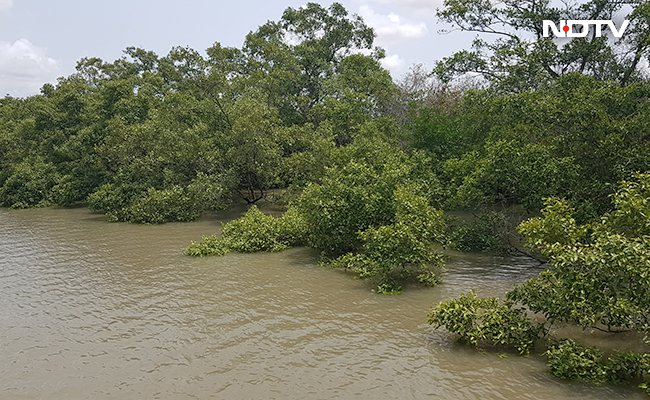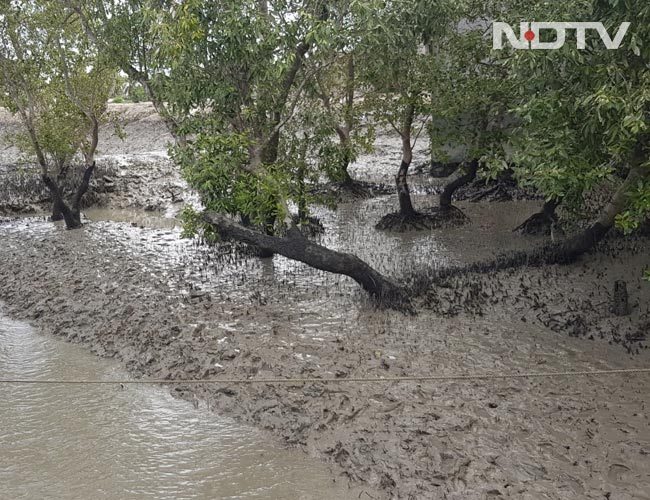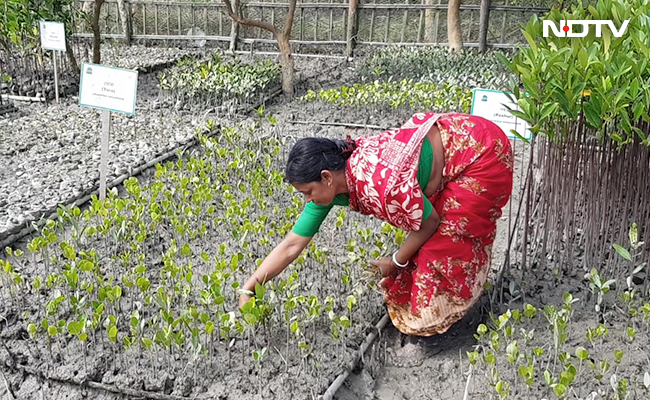New Delhi: Sundarbans, the world’s largest contiguous mangrove forest spread across West Bengal in India and Bangladesh, gets its name from Sundari, the local name of the mangrove species Heritierafomes Buch-Ham. (ME). Sundari means beautiful in Bangla but today, the beauty and survival of Sundarbans is threatened due to the depleting mangrove cover. As per the Forest Survey of India, in the last decade, very dense mangrove cover in West Bengal has declined by 4.23 per cent – from 1,038 square km in 2011 to 994 square km in 2021. But why are mangroves critical for life as we know it in Sundarbans and what are the implications of the diminishing protective cover of mangroves?
At present, the Sundarbans on the Indian side consist of 9,630 square km, out of which the mangrove area consists of 4,266.6 square km which is the forest area and includes rivers like Saptomukhi, Thakuran, Matla and Goasaba. These mangroves are the backbone of Sundarbans as they act like shock absorbers, reducing the fury of cyclonic storm and preventing erosion due to tidal action. These are not only dominant as fringing mangroves along the creeks and backwaters, but also grow along the sides of rivers in muddy as well as in flat, sandy areas.
In Pics: World Environment Day 2022: How Climatic Change Is Depleting Lives in Sundarbans
The extremely rich diversity of aquatic and terrestrial flora and fauna makes for the livelihood of the 4.5 million people living in the Sundarban Biosphere Reserve. Living in close proximity to forest area, the people depend directly on forest and forest-based resources for their sustenance. From fuelwood for thermal energy, thatching leaves, cutting trees for timber, to forest resources like fishes, crabs and honey, all come from mangroves and help people make ends meet.
Dr Pradeep Vyas, Indian Forest Service, Ex-Chief Wildlife Warden, West Bengal says,
Sundarbans act as a nursery for fishes with mangroves helping fishes to multiply. If mangroves are destroyed, there will be less production of fish and as a result, in the entire Bay of Bengal coastline which has West Bengal, Odisha, Andhra Pradesh, and Tamil Nadu, in all these areas, fish production will go down. This will incur a huge economic loss to the people and their livelihood.
The Loss Of Mangroves, Especially Sundari, The Crown Of Sundarbans
Ajanta Dey, Joint Secretary and Programme Director at Nature Environment and Wildlife Society categorises mangroves into two types – fresh water loving and salt water loving. She says,
We have 84 documented types of mangrove species of which some have an affinity for salt water and others have for fresh water. Species like Sundari and Nipa love fresh water whereas Avicennia (grey mangrove or white mangrove) can sustain high salinity. Due to the lack of availability of freshwater in Indian Sundarbans, species like Sundari, which used to be dominant specie, is disappearing. In fact, all fresh water loving mangrove species are now getting replaced with the ones that can withstand salinity.
The slow death of the Sundari specie began in the 1800s when Sundari trees were cut for their timber which was used in building and expanding the railway tracks within the delta region. The logging of trees was practised under colonialism. Apart from this, paucity of freshwater and rising salinity added fuel to the fire.
During the 16th century, there was a neo-tectonic shift which means delta tilted towards the eastern side, as a result of which the massive flow of Ganga got diverted towards Bangladesh. In turn, freshwater loving species including Sundari started to decline. Today, you will find Sundari towards the Eastern side of Indian Sundarbans, adjoining to Bangladesh, but its growth is stunted. The Sundari trees in Bangladesh are majestic and their growth is 20 times more than what you will see in India, explains Dr Vyas.
In Pics: World Environment Day 2022: Sundarbans – The Land Of Tigers Faces Threats By Climate Change
Additionally, it is the 1996 Ganges Water Sharing Treaty between India and Bangladesh as part of which, India has to give away a certain amount of water to Bangladesh. To top this, various dams have been built like the Farakka Barrage which blocks the natural flow of the river. Ananda Banerjee, Author and Conservationist adds,
There are ecological consequences of building a dam which we realise in the longer run. A dam diverges the river and changes the bank and the flow of fish and other river organisms. The Farraka broke the natural flow and then over time, more water has been drawn out of it. The freshwater flow in the delta has been slowly decreasing because we have dammed rivers, pulled water for agriculture, for industry and for urban usage.
There are different elevations even in a mangrove forest – from sea level to upper reaches where the ground is not totally inundated. Sundari will only grow if the ground is not inundated with saline water, says Mr Banerjee.
Ecologically delta is a highly volatile space. It’s a place where new lands are formed and older ones get submerged. But the core issue is the inadequate flow of fresh water into the delta.
If the ecological flow is not getting met at a certain point, obviously the other side will come in to fill the vacuum. In the case of Sundarbans, since there is not much freshwater flow, the sea water comes in to take up the deficit space, explains Mr Banerjee.
The high salinity affects the growth of mangrove trees – either they die an early death or their growth is often stunted, making them look like bushes. Talking more about the salinity, Dr Vyas said that the sudden rise in salinity is mainly due to climate change. He said, when temperature increases due to climate change, it improves the dissolution of salt in the water which increases the salinity.
Also Read: #OnlyOneEarth: Stark Facts About Environment You Must Know
There are anthropogenic reasons as well behind the clearance of mangrove trees and the decrease in the flow of fresh water in Sundarbans. Ms Dey says,
I read old documents that state, “Tiger on the land, crocodile in the water and all around rivers” – this is how Sundarbans used to be. After Bangladesh’s Independence, a lot of people settled in the Indian Sundarbans. Mangrove forest was cleared for habitat purposes and aquaculture. In the late 80s, there was a boom in the business of shrimps and prawns and for that, people cleared mangrove trees, unaware that these trees are the reason behind bountiful fish, shrimps, and crabs. This trend still continues; illegally people cut mangroves for shrimps.
The Importance Of Sundarbans, Home Of A World Heritage Site And A Biosphere Reserve
But besides the habitation area, Sundarbans is also a forest reserve. A trip to the Sundarban Tiger Reserve on a boat, the only way to tour the dense forest, exposes one to lush green mangrove trees on both sides of the river. For their livelihood, people often enter the forest and risk their lives by coming in close contact with wild animals including tigers. Deleen Baidya, a fisherman from Dulki, Gosaba had gone to Sajnekhali Forest on July 11, 1999 to catch fish. He never returned home that day. A Tiger got hold of him and he was killed, leaving behind his wife and five young children – four daughters, and a son.
The pain of her husband’s tragic death is still raw for Geeta Baidya. She breaks down while recounting the horror that unfolded on the day, she lost her husband and that was the beginning of a long hard struggle for survival for her and her children.
My husband had gone to catch fish that is when a tiger attacked and took him. I had to really struggle to provide for my children. I could not educate any of my children. My son has been working since his childhood to run the household, she said.

Geeta Baidya broke down while recounting the death of her husband who had gone for fishing and was caught by a tiger
The man-animal conflict is a harsh reality for Sundarbans. Even today deaths like that of Deleen Baidya are quite common. In a recent case, as reported by news agency PTI on May 30, a 45-year-old fisherman was killed in an attack by a Royal Bengal Tiger in Sundarbans National Park in West Bengal’s South 24 Parganas district.
Sannasi Mondal, a resident of Kumirmari village in the Gosaba block of the district, along with three others had gone to the forest to catch crabs and collect honey on Saturday (May 28). After a day’s hard work, they spent the night on the boat. While they were sleeping in their boat on Sunday morning, the tiger, which had quietly approached them unnoticed, suddenly attacked Mr Mondal and grabbed him by his neck, the forest officer said.
According to the data provided by Sundarban Tiger Reserve Division, 91 people have been killed since 2015 due to the human-tiger conflict in Sundarbans. Of this, 79 people didn’t receive any compensation due to illegal entry inside Sundarban Tiger Reserve whereas, 12 have received compensation due to legal entry. Though entry deep into the forest is restricted, people still go to make a living and catch fishes and crabs. One of the reasons for this risky venture into the jungle, is the lack of job opportunities and this was evident when the pressure on the forest increased during the COVID-19 pandemic. Tapas Das, Chief Conservator of Forests and Field Director, Sundarban Tiger Reserve said,
During COVID-19, people who had migrated to cities returned to Sundarbans. They had to make ends meet. Secondly, tourism was heavily affected which resulted in another loss of income. Since everything was shut and there was no means to make a living, people resorted to the forest. The number of fishermen entering the forest increased, some with and some without a license because everyone had to earn a living.
This pressure on the forest also increases after a calamity. For instance, after Cyclone Aila in 2009, Dr Vyas did a study and found that even after a year of the cyclone, 23 per cent of the agricultural land could not be cultivated. As a result, people had to move from agriculture to aquaculture and enter forest areas for their livelihood.
What Is The Government Doing To Protect Mangroves And Reduce Human-Tiger Conflict?
In 2020, after the devastation caused by Cyclone Amphan, the Chief Minister of West Bengal, Mamata Banerjee called for 5 crore mangrove plantation to restore the natural barriers. The programme also provided job opportunities to the locals as it was implemented under the Mahatma Gandhi National Rural Employment Guarantee Act 2005 (MGNREGA).
We are planting mangrove trees but not expecting all of them to survive. If you plant today, only 50 to 60 per cent of the trees will survive by the next year. This means you have to replant year after year, at least for four to five years and we are taking this additional burden. We are focused on covering the ground area rather than planting n number of trees. In the South 24 Parganas districts, 4 crore trees will be planted and survive, says Sourabh Chatterjee, District Nodal Officer of South 24 Parganas for MGNREGA and Mangrove Plantation.
Mr Chatterjee also informed the different ways of planting – one is to plant seedlings but that offers a low survival rate; the second option is to raise nurseries of mangrove saplings and plant saplings which yields a higher survival rate.
Also Read: Geographical Vulnerability, A Make Or Break For Access To Healthcare In Sundarbans
Home to the endangered Royal Bengal Tiger, Sundarbans is the only mangrove tiger habitat in the world. According to a report released by PM Modi on July 29, 2019, the number of tigers has gone up in the Sundarbans from 76 in 2014 to 88 in 2019. In order to protect people from tigers, the forest department has put up nylon net fencing that extends to 105 kms.
This acts as a social and psychological barrier for the tiger. Due to this fencing, there are very less tigers straying in the villages – 2-3 per year. Secondly, we are involving people in road construction, creation of sweet water ponds, solar street lights and including alternate income generation activities, said Mr Das.
The Future Of The Sundarbans
Though the future seems to be very bleak for the people and the ecosystem of Sundarbans, people are hanging on to the flickering hope. One option is to plant more and more mangrove trees because, at the end of the day, they survive high tides and cyclones and protect the entire ecosystem critical for the survival of all life forms. While planting one has to consider the terrain and the salinity profile and pick the specie accordingly, say experts.
Ms Dey believes that we are losing time when it comes to saving the Sundarbans, especially the Sundari specie. The focus needs to be on protecting the delta, she says and adds,
If the delta survives, we will survive and mangroves will survive. We have to rejuvenate the fresh water connect of these rivers. We cannot give the fight away. The government and NGOs don’t have enough capacity; we need to involve local communities.
48-year-old Ganga Ghosh, a resident of Amlamethi Village in Gosaba Block was born and raised in Sundarbans. Since childhood, she is familiar with storms, high tides and cyclones but in the past few years, she has witnessed a rise in climate extremities. She says,
Growing up, we would witness storms once in three years or even longer but now, we see two to three storms in a year. The saline water has taken over the fresh water.

Ganga Ghosh’s erstwhile house in runs – it was first devastated by cyclone Aila and then by cyclone Amphan
Due to lack of job opportunities in Sundarbans, Ganga Ghosh’s son has moved to the city while she continues to live on the fringes with her husband, daughter-in-law and grandchildren.
Since Cyclone Amphan, 31-year-old Aparna Dhara’s house has been destroyed twice but her love for the land and the will to protect and restore overpowers the fear of natural disasters. Ms Dhara, a resident of Lakshmipur village in Kakdwip block says that the area she lives in didn’t have many trees and high tides would break the banks. Today, she is associated with Nature Environment and Wildlife Society and supports mangrove plantation to bring back mangroves in the region.
Women like Ganga Ghosh, and Aparna believe it is their responsibility as the inhabitants of Sundarbans to preserve the beauty of the place so that their future generations get to see the Sundarbans they had seen in their childhood. Together they are creating nurseries and planting trees because they are hopeful that their Sundar (beautiful) land will retain its green glory and survive any threat to its existence.
Also Read: How Has Climate Change Impacted Food Security In India’s Sundarbans
NDTV – Dettol have been working towards a clean and healthy India since 2014 via the Banega Swachh India initiative, which is helmed by Campaign Ambassador Amitabh Bachchan. The campaign aims to highlight the inter-dependency of humans and the environment, and of humans on one another with the focus on One Health, One Planet, One Future – Leaving No One Behind. It stresses on the need to take care of, and consider, everyone’s health in India – especially vulnerable communities – the LGBTQ population, indigenous people, India’s different tribes, ethnic and linguistic minorities, people with disabilities, migrants, geographically remote populations, gender and sexual minorities. In wake of the current COVID-19 pandemic, the need for WASH (Water, Sanitation and Hygiene) is reaffirmed as handwashing is one of the ways to prevent Coronavirus infection and other diseases. The campaign will continue to raise awareness on the same along with focussing on the importance of nutrition and healthcare for women and children, fight malnutrition, mental wellbeing, self care, science and health, adolescent health & gender awareness. Along with the health of people, the campaign has realised the need to also take care of the health of the eco-system. Our environment is fragile due to human activity, which is not only over-exploiting available resources, but also generating immense pollution as a result of using and extracting those resources. The imbalance has also led to immense biodiversity loss that has caused one of the biggest threats to human survival – climate change. It has now been described as a “code red for humanity.” The campaign will continue to cover issues like air pollution, waste management, plastic ban, manual scavenging and sanitation workers and menstrual hygiene. Banega Swasth India will also be taking forward the dream of Swasth Bharat, the campaign feels that only a Swachh or clean India where toilets are used and open defecation free (ODF) status achieved as part of the Swachh Bharat Abhiyan launched by Prime Minister Narendra Modi in 2014, can eradicate diseases like diahorrea and the country can become a Swasth or healthy India.
[corona_data_new]





























